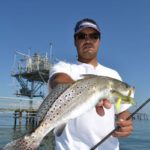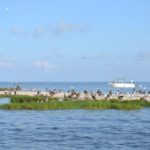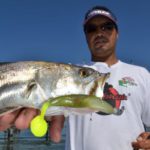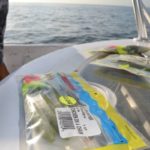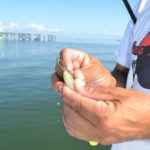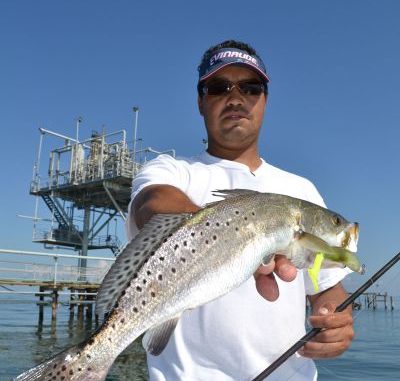
This highly eroded basin continues to deliver crazy numbers of speckled trout this time of year.
It’s axiomatic that you never leave feeding fish to find feeding fish.
That old adage might make a great bumper sticker, but you’ll never find it on Capt. Chad Billiot’s truck.
The Houma Indian, a veteran of 23 years of guiding in the Timbalier and Barataria basins, spent a picture-perfect, flat-calm, Chamber-of-Commerce morning last May fishing several islands and platforms in Timbalier Bay looking for bait.
Billiot wasn’t toting a cast net or a trawl. He didn’t want the bait to actually put in his livewell.
But he knew that the immediate task at hand — the missing piece of the puzzle — was to locate a school of baitfish. Find the prey, and you find the predators.
But a tide that was peaking from an overnight rise let the bait roam free in the massive bay. Without the current forcing it to group up in the energy-preserving protection of eddies, the mullet and pogies could lollygag wherever they damn well pleased without having to look over their shoulders for the packs of swimming wolves with spots on their coats.
Billiot hit a few spots and made some cursory casts, but until the tide started moving, he knew he was just biding his time. He hit Pelican Island, a favorite sandbar in the yawning sprawl between East Timbalier and West Timbalier, a couple of no-name rigs and even West Timbalier itself.
But the net haul was zero speckled trout.
Still, Billiot was about as worried as a retired tourist finishing his third piña colada on a beach in Aruba.
He knew the day was perfect, and the trout were thick in the area. It was a foregone conclusion that he’d find them somewhere.
Finally, he stopped at a reef off of Brush Island, and looked over at the pathetic remnant of the island itself. Two large schools of mullet had formed up on either side of the island’s westernmost point, and Billiot knew what that meant.
He trolled within casting distance, and for at least a split second, the trout couldn’t believe their good fortune that a mullet with a flaming chartreuse tail had broken away from the rest of the school to swim like it had forgotten its medication.
Billiot pulled several fish from the school, and clearly could have sat there and finished his limit within an hour — two at the most — but the fish he was catching were mostly grunting and croaking males, solid 1-pounders but Billiot was hoping for bigger fish on his Salt Water Assassin swim baits.
“I think we might try a couple of platforms around here to see if the females are still sitting deep and the little males are on the bars right now,” he said. “Maybe those females haven’t related to the bars just yet, which means that they should probably be by one of those platforms.”
So he left feeding fish to go find feeding fish.
“I’m a greedy fisherman,” Billiot said. “I like to see big, nice sows, and that’s what we’d planned on targeting today was some decent-sized sow trout.”
Billiot’s first stop was at Tank Battery No. 6 in the Caillou Island Field. He made two casts to a satellite while trolling within range of the platform’s flow lines. His third cast was greeted instantly by that old distinctive tap that we all love. Billiot set the hook, and his rod bowed.
Another trout — this one a 2 ½-pound female — went into the Yeti.
The next cast produced the same result. And the next one. And the next one.
Not all the fish were 2 ½ pounds — some were 3 ½ and others were 1-pound croaking males — but the heaviest five easily would crack the 15-pound mark. They were the aggressive summer fish that become enraged when you hook them and wriggle at the end of the line for 30 seconds after you hoist them over the gunwale, refusing to let you get your hands around their massive shoulders.
They were exactly the fish Billiot had planned to catch, even if the location was slightly different.
“When we left the dock, we assumed we were getting close to the moon phase, and maybe they’d be out on the beach line or shallow sandbars doing their spawning job,” Billiot said.
Some fish were there indeed, but mostly only small males. So Billiot successfully called his shot by leaving the smaller fish, theorizing that the bigger females hadn’t moved to the islands yet.
“May 7 is the opening day of shrimp season for this area, so this is where the brown shrimp are supposed to be right now, all around these big, open bays and platforms,” he said while unhooking another big female. “The primary forage for them right now is shrimp until they fatten themselves up to lay their eggs.
“So if you’re a couple days early, this is where they should be.”
May 7 was the opening date of the 2012 season, and Billiot was fishing the area on May 4. The 2013 shrimp season will be set at the Louisiana Department of Wildlife & Fisheries Commission meeting the first week of May.
It was no accident that the distinctive characteristic of the platform Billiot fished was that it was rich with flow lines emerging from the main structure and connecting several satellites.
“Flow lines are basically structure for them to relate to,” he said. “You’ve got pipes, pilings, a mix of everything, out here. Flow lines are giving them structure all the way from the top to the bottom.”
Billiot explained that the water where he was fishing was 6 feet deep, but the actual flow lines at this platform were 3 feet below the surface. The fish were suspended, holding right on the flow lines, and Billiot caught them on every cast.
In fact, they were so thick and the water was so pristine that Billiot could often see the flash of the fish hitting the bait, and would watch packs of three to five trout come up with the hooked fish, trying to get the lure out of its mouth.
On one occasion, a 25-pound bull red followed a hooked trout to the boat, nipping at the fish’s tail and hoping to get a little sushi for lunch.
May in Timbalier Bay is just a no-brainer month. The fishing truly is that easy. Just move and move and move until you find them, and eventually you WILL find them.
The only caveat, of course, is the weather. Sometimes May mistakenly thinks it’s March, and comes both in and out like a lion.
“We’ve been catching a lot of trout,” Billiot said during the trip last May. “It’s just a matter of getting the weather to cooperate with us. And, of course, the last five days, it’s been blowing 25 (mph) plus out of the south and east.
“That’s been the difficult thing for us: actually getting out here, but every time we’ve gotten out here and been able to fish the pattern we wanted, we’ve caught plenty of trout — and a lot of quality trout.”
One of Billiot’s favorite baits for the month of May is a Salt Water Assassin Die Dipper swim bait. It’s a big, meaty lure with a tremendous amount of tail action. It’s made of the same ultra-soft, supple plastic for which Salt Water Assassin and Bass Assassin lures are known, and that’s responsible for its outstanding action. On the downside, trout absolutely destroy these baits, and it’s rare you’ll catch more than one or two on an individual bait.
To make each lure last a little longer, Billiot uses Salt Water Assassin long-shank, screw-lock jigheads. These weighted hooks have a thin, corkscrewed wire emerging from the head and running down the top part of the hook. This allows the bait to be “screwed” onto the jighead.
The Die Dipper is Billiot’s go-to bait this time of year when he wants to catch bigger trout.
“It looks and acts like a mullet in the water,” he said, “and big trout love mullet.
“It’s a 5-inch shad bait made to give you a bigger presentation. Most of these trout are trying to find food that’ll sustain them for their spawning season.”
If he’s fishing with clients who prefer numbers to size, he’ll forego the Die Dippers and fish smaller Salt Water Assassin baits instead.
This time of year, Billiot will often start his day fishing the many sandbars between East Timbalier and West Timbalier islands, or the actual beaches themselves. This is only possible when winds are calm or trickling out of the north.
But when the weather allows it, the action is some of the best of the year, and Billiot likes to attack the sand with topwater plugs.
“To me, a topwater bait in the early part of the summertime is like a long-range fish finder, because if you can just find where the trout are sitting in the surf, then you’re going to catch them immediately,” he said. “Usually, if you find one or two, then you’re going to catch the whole bang of them.
“If I see mullet or other bait on the surf, I’ll just start slinging that topwater around. They’ll tell me where they’re at. Then I can stop and start fishing with jigs if I want, or just stick with the topwater.”
The strong action in the area is kicking off right now, and will last at least through the month of August. Billiot sticks with artificials throughout May and June, and often in July and August, as well, but sometimes in the latter two months, live bait can mean the difference between a mediocre trip and a bad one, he said.
When he uses it, Billiot cast-nets his own pogies and croakers. He has a couple of secret spots that always deliver croakers for him. Pogies, on the other hand, are usually easy to find along the northern end of Lake Raccourci. All you need is a 10- or 12-foot cast net and a round livewell with a strong aerator.
But his preference is always to fish artificials because he can cover more water with them.
And sometimes that means leaving feeding fish to find feeding fish.
For more information, contact Capt. Chad Billiot at 985-637-5058.
